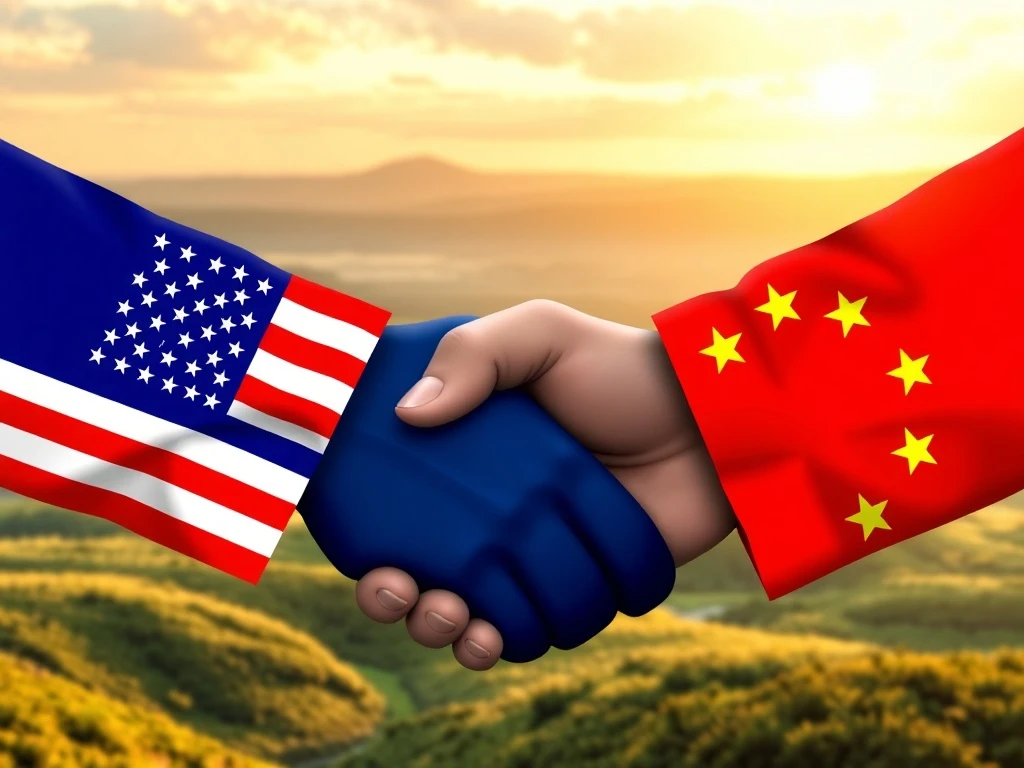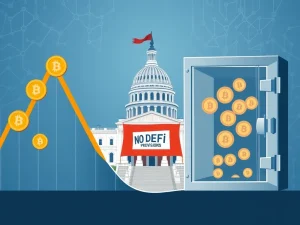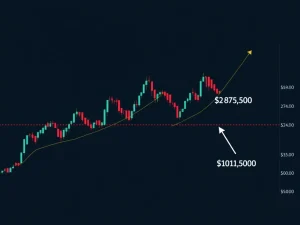Trump EU Trade Deal: Unprecedented Accord Averts Trade War, Ignites Crypto Surge

The cryptocurrency world held its breath as global trade tensions escalated, but a recent breakthrough has sent ripples of optimism, particularly through the digital asset markets. The landmark Trump EU trade deal, announced on July 27, 2025, didn’t just avert a potential trade war; it catalyzed a significant surge in Bitcoin’s price, signaling a renewed confidence in global economic stability. For investors and crypto enthusiasts alike, understanding the nuances of this agreement is crucial to grasping the broader market movements.
Averting a Global Trade War: The Landmark Trump-EU Deal
The specter of a full-blown trade war averted was a primary relief for markets worldwide. President Donald Trump and European Commission President Ursula von der Leyen finalized a substantial $1.35 trillion trade agreement. This pivotal deal includes a 15% tariff on most EU goods, a compromise from the initially threatened 30% but an increase from the existing 10% on some items like auto exports. Notably, automobiles were excluded from this new tariff rate, aligning with Trump’s strategy of using tariffs as leverage for reciprocal investments.
The agreement outlines specific commitments from the European Union, which are designed to benefit the U.S. economy directly:
- Energy Purchases: The EU committed to purchasing $750 billion in U.S. energy resources. This move aims to bolster U.S. energy independence and position it as a key global supplier.
- Infrastructure Investments: An additional $600 billion is pledged by the EU for investment in U.S. infrastructure projects. This investment is expected to stimulate economic growth and job creation within the United States.
This comprehensive framework demonstrates a strategic approach to international trade, focusing on mutual economic benefits rather than punitive measures.
Bitcoin’s Unprecedented Surge and the Broader Crypto Market Reaction
Perhaps the most eye-catching development following the announcement was the immediate and robust crypto market reaction. Bitcoin, often seen as a barometer for global financial sentiment, surged dramatically, nearing an astonishing $120,000. This rally reflects investor optimism that the deal would bolster global economic stability and reduce systemic risks, making digital assets an attractive proposition.
Beyond Bitcoin, other cryptocurrencies also experienced significant gains:
- Binance Coin (BNB): Reached record highs, underscoring the positive sentiment permeating the digital asset space and the broader altcoin market’s response to macroeconomic clarity.
- Overall Crypto Market: The positive momentum in leading cryptocurrencies often cascades into the wider market, indicating a collective sigh of relief and renewed confidence among crypto investors.
Traditional markets, however, showed a more nuanced response. U.S. stock futures initially dipped as investors digested the implications of higher tariff risks. However, they quickly stabilized as the deal’s potential to prevent a full-scale trade war escalation became clear. This mixed initial reaction highlights the complexity of assessing geopolitical events’ immediate impact on diverse financial sectors, though the crypto sector’s response was notably bullish.
Beyond Tariffs: How the Deal Bolsters Global Economic Stability
The Trump EU trade deal is more than just about tariffs; it’s a strategic framework aimed at enhancing U.S. economic resilience and influence on a global scale. Analysts note that the focus on substantial energy and infrastructure investments aligns with Trump’s broader goals of reducing U.S. trade deficits and enhancing energy independence. This energy component is particularly significant, positioning the U.S. as a key supplier to the EU, which in turn reinforces geopolitical goals of countering Russian influence in European energy markets. This long-term strategic investment contributes significantly to perceptions of sustained global economic stability, which is a boon for all risk assets, including cryptocurrencies.
The Blueprint for Future Trade: Implications and Challenges for the Trump EU Trade Deal
This agreement sets a precedent, mirroring a similar arrangement with Japan, where Trump secured a $550 billion investment in exchange for 15% tariffs on Japanese goods. This pattern of using tariffs as leverage to secure reciprocal benefits has become a hallmark of Trump’s trade strategy, signaling a new phase in U.S. trade policy that blends aggressive protectionism with strategic investment incentives. While the immediate Bitcoin price surge is a clear indicator of market confidence, questions remain regarding long-term implications and potential challenges.
Critics argue that despite the immediate relief of a trade war averted, the agreement may not fully resolve long-standing structural issues, such as barriers to American agricultural exports in Europe. Furthermore, implementation challenges remain. Ensuring the pledged investments materialize as promised and avoiding potential EU retaliatory measures will be crucial for the deal’s sustained success. As the U.S. and EU finalize details, attention will turn to the deal’s broader implications for global trade dynamics and how it will truly impact long-term market trends.
Conclusion
The Trump EU trade deal marks a significant moment in global trade relations, showcasing a strategic shift in U.S. policy. By successfully navigating the brink of a trade conflict and securing substantial investments, the U.S. aims to bolster its domestic industries and enhance its geopolitical standing. The positive crypto market reaction, especially Bitcoin’s impressive surge to near $120,000, underscores the digital asset world’s sensitivity to macroeconomic developments and its potential as a safe-haven or growth asset during periods of increased clarity and reduced uncertainty. As details are finalized and implementation begins, the world will watch closely to see if this landmark agreement truly paves the way for sustained global economic stability and continued innovation across all markets.
Frequently Asked Questions (FAQs)
1. What is the core of the Trump-EU trade deal?
The core of the deal is a $1.35 trillion trade agreement that includes a 15% tariff on most EU goods, a compromise to avert a potential trade war. In return, the EU committed to purchasing $750 billion in U.S. energy and investing $600 billion in U.S. infrastructure.
2. How did the deal impact Bitcoin’s price?
Following the announcement, Bitcoin surged significantly, reaching near $120,000. This positive crypto market reaction reflected investor optimism about reduced global economic uncertainty and increased stability.
3. What are the key financial commitments made by the EU in this deal?
The EU committed to purchasing $750 billion in U.S. energy and investing an additional $600 billion in U.S. infrastructure projects, totaling $1.35 trillion in economic activity.
4. Are there any criticisms or challenges associated with the deal?
Critics argue the deal may not resolve long-standing issues like barriers to American agricultural exports. Implementation challenges also remain, particularly ensuring the pledged investments materialize and avoiding potential EU retaliatory measures.
5. How does this deal compare to other U.S. trade agreements under Trump?
This deal mirrors a similar arrangement with Japan, where a $550 billion investment was secured in exchange for 15% tariffs on Japanese goods. It highlights a consistent strategy of using tariffs as leverage for reciprocal benefits and investments.










